 This week I came across a Department of Homeland Security (DHS) survey through one of my Google Alerts. (Alerts are a great resource; find out about them here.) The survey is currently being put out to residents in several counties in Washington State.
This week I came across a Department of Homeland Security (DHS) survey through one of my Google Alerts. (Alerts are a great resource; find out about them here.) The survey is currently being put out to residents in several counties in Washington State.
It turns out that DHS has been conducting similar surveys in different communities since 2001, trying to track trends in preparedness.
And yes, some trends have emerged. For example, the surveys have found that full time employees have the highest level of personal readiness compared with other types of employees. People with children in school also report higher preparedness levels. And, as you might expect, different parts of the country have different levels of preparedness.
Overall, though, American preparedness has not improved markedly since 2001!
We here at Emergency Plan Guide are trying to change that trend!
Can we take advantage of this survey to improve the preparedness in our local groups?
I’m not suggesting that we use it like DHS does. I see some other uses appropriate for your local CERT meeting.
A look at the original survey.
Before I add my comments, here’s (nearly) the whole survey. (I edited it slightly.) Take a look to see what YOU think about it. (It is LONG. Scroll through quickly to get an idea of the scope and format.)
Citizen Expectation Survey (from Homeland Security)
1. My home is located in the following area
2. My household includes: (Check all that apply)
- Child (Birth – 5 years)
- Senior Citizen(s) (65 and over)
- Disabled Family Member(s)
- Non-English Speaking Member(s)
- Household Pet(s)
- Tribal Member(s) (and Affiliation)
3. What’s your main source of local, state, and national news and information?
- Television
- AM/FM Radio
- Newspaper/Magazine
- Internet
- Social Media
4. How do you primarily receive your local weather forecast information?
- Television
- AM/FM Radio
- Newspaper/Magazine
- Internet
- Social Media
5. What is the best way of delivering severe weather or disaster news and updates to you?
- All Hazards Weather Radio
- AM/FM Radio
- Television
- E-mail
- Phone Call
- Text message
- Twitter
- Facebook
- Other Social Media
6. Does your family have a Family Emergency Plan?
7. Does your Family Emergency Plan include: (Check all that apply)
- I do not have a Family Emergency Plan
- My plan includes how to contact each other in the event we were separated during a disaster (phone, text, e-mail addresses)
- My plan includes an out-of-state family contact person for when all local communications are down
- My plan includes a specific meeting place in the event my family is separated
- My plan includes how and where to evacuate to in the event we must abandon our home during a disaster
- Other
8. Does your or your child’s school have an Emergency Plan for disaster?
- I have no children
- I have no children who attend school
- Yes
- No
- Unsure
9. Does your workplace have an Emergency Plan for disaster?
- I am not currently employed
- Yes
- No
- Unsure
10. Do you and all other members of your family, including your pets have a GO KIT, Get Away Bag or similar item? (Check all that apply)
- Myself
- Each family member
- My pet
- We have none
- I do not know what a GO KIT or Get Away Bag is
11. I am aware of the risk and hazard to all local disasters, such as, earthquake, tsunami, severe weather, flooding, tornado and wildfire.
- Yes
- No
- Unsure
- I have no risk or hazard to any of these disaster events
12. I expect an Earthquake to affect my community in the next:
- year
- 3 years
- 5 years
- 10 years
- longer than 10 years
- never
13. I expect a Tsunami to affect my community in the next:
- year
- 3 years
- 5 years
- 10 years
- longer than 10 years
- never
14. I expect Flooding to affect my community in the next:
- year
- 3 years
- 5 years
- 10 years
- longer than 10 years
- never
15. If a disaster is threatening, my expectation is, I will receive warning and instructions from the following: (Check all that apply)
- Local City Government
- Local County Government
- Tribal Government
- State Government
- Federal Government
- ALL Hazard Alert Weather Radio
- National Weather Service
- Local Emergency Management
- Local Law Enforcement
- Local Fire Department
- Television
- AM/FM Radio
- All Hazard Alert Broadcast Siren (AHAB Warning Siren)
- FEMA
16. If a disaster situation was imminent, would you evacuate your home if warned to do so by official authorities?
17. If you had a 10 hour advance warning of the need to evacuate your home, how long would you expect it to take, to prepare and leave your home, once you receive the initial evacuation warning?
- I would not evacuate
- Under an hour
- 1-2 hours
- 2-4 hours
- 4-6 hours
- Longer
18. If you were to evacuate following a warning given by local authorities, would you bring your pet(s) with you?
- Yes
- No
- Unsure
- I have no pets – I would evacuate
- I have no pets – I would not evacuate
19. If you were to evacuate following an order given by local authorities, where would you most likely go?
- I would not leave my home
- I would stay with family/friends in my County
- I would stay with family/friends in an area other than my County
- I would stay in a hotel/motel in my County
- I would stay in a hotel/motel in an area other than my County
- If none of the above, explain where you would go.
20. What modes of transportation are available to you in the event you have to evacuate from your home? (Check all that apply)
- I have no available transportation
- Private automobile
- Public transportation
- Bicycle
- I would rely on friends or family
- Other (please specify)
21. I expect emergency response agencies to assist me if I must evacuate my home.
22. If my County were impacted by a significant disaster event lasting multiple days, I expect Federal and State Response Agencies, including FEMA and the Red Cross, to respond within:
- 12 hours
- 24 hours
- 2 days
- 3 days
- 4 days
- Longer than 4 days
23. If my County were impacted by a significant disaster event lasting multiple days, I expect Local, City and County Response Agencies to respond within:
- 12 hours
- 24 hours
- 2 days
- 3 days
- 4 days
- Longer than 4 days
24. In a significant disaster event lasting multiple days, who would you seek out to obtain food or shelter assistance?
- School
- City Hall
- Local Fire Department
- Local Police Department
- Church
- Hospital
- Unsure
- Other
- If other, please specify here
25. Have you signed up for the Emergency Alert and Notification System in your county?
- Yes
- No
- I do not know if we have an Alert and Notification System in my county.
26. Do you have a NOAA All Hazards “Alert” Weather Radio?
27. Which news headline would likely interest you enough to read the associated article?
- A Huge Winter Storm is Approaching With Winds Exceeding 150 mph and a Large Storm Surge.
- We’re Awaiting One of the Most Extraordinary, Mind Boggling, Meteorologic Marvels, Never Before Witnessed by any Earthbound Creature.
- Neither Headline Would Interest Me Enough to Continue Reading the Article.
28. Please indicate if you would like more information on any of the following:
- Evacuation
- Disabled/Functional Needs Disaster Preparedness
- Livestock Preparedness/Evacuation
- Pet Preparedness/Evacuation
- Family Preparedness
- Business Preparedness
- School Disaster Preparedness
- My Local County Emergency Management
- Disaster Mitigation
- Disaster Response
- Disaster Recovery
- FEMA/Flood Programs
- Evacuation Routes/Shelters
- Communications
- Earthquake
- Tsunami
- Severe Weather
- Disaster Volunteer Organizations
- My Local County Emergency Notification System
29. Do you have suggestions, comments, questions or constructive criticism? Please write your comments or concerns here. (If you desire a reply, please leave your name, email, and phone number).
How to use the survey as training material.
I’m usually an enthusiastic survey taker (or interview giver), but this survey is so long that even I felt like abandoning it halfway through.
Therefore, my first idea would be to divide the survey up into several sections or themes and use each one as part of, or the main focus of, a group meeting. For example:
- Ask group members to complete a section of the survey themselves, and then use that section for discussion.
- Assign sections of the survey to sub-groups and have them prepare background material or collect samples to share with the others.
- Create still another version of the survey for neighbors who aren’t yet part of the group. You wouldn’t collect the surveys, but would design them as “eye-openers” for your neighbors!
Family Needs – Questions 1 – 5
Every family is different. Poll the group to detect commonalities. Share resources, such as the best TV channels for weather news, etc. What particular challenges would you have associated with children, older people, people not speaking English, etc.? What actions can your group take to help meet some of these challenges?
Individual Family Plans – Questions 6 – 9
If your group is not likely to have plans, whether family or work related, perhaps you can focus on providing step-by-step instructions on what should be included. At Emergency Plan Guide, we devote about half our Advisories to one facet or another of planning! Here’s a recent article on building a Family Plan and a one-pager for increasing workplace preparedness.
Building a Go Bag – Question 10
Provide people with a list; call a meeting that focuses on “show and tell” using one of the leaders’ bags. At work, make copies of “What to take with you” and distribute them. Check out our new custom survival kit workbook for families, too — it works for all families and can be an excellent benefit for employees.
Likely Threats – Questions 11 – 14.
We’ve had good luck getting experts to train us on different natural and man-made threats. YouTube has great resources, too. Stick with the threats that are most likely; no need to overwhelm everyone with EVERY possible threat! People will have their own amazing stories to share!
Warnings and Evacuation – Questions 15 – 26
Traditionally, about half the people, when asked, say they will NOT evacuate! Be sure people understand how and when to evacuate, and the fact that once they’re out, they can’t come back. Don’t forget to discuss how people with disabilities will be assisted to evacuate, and how to handle pets and large animals. In particular, note how long it might take for “authorities” to show up with help. (Check with your local Red Cross.) “Evacuation Realities” would be a popular topic to attract all kinds of visitors to a group meeting.
As for the “warnings,” you can help people know what to expect locally, show them how to sign up for local alert apps, and see if you can arrange for the purchase of NOAA Weather Radios.
Not sure I’d include – Questions 27 – 29
Caution: You may find some of these questions ask for information that you consider “too personal” to share openly. Feel free to remove or adjust those questions. In any case, be sure to discuss with your group the importance of privacy and how to maintain it.
Training is an ongoing challenge. (That’s why I pulled together my book on CERT Meeting Ideas.)
Finding already-developed materials like this survey is a boon to CERT group leaders. While this particular survey wasn’t designed for groups, it can certainly work as a refresher, as a discussion starter, or even as an agenda for several separate meetings.
Let us know if and how you find it useful!
Virginia
Your Emergency Plan Guide Team



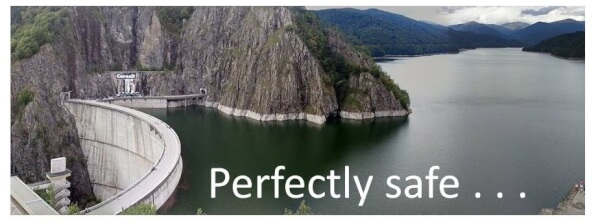 Maybe the people who live near the 90,000 or so dams in the United States! (BTW, Texas has more dams than any other state, followed by Kansas . . .)
Maybe the people who live near the 90,000 or so dams in the United States! (BTW, Texas has more dams than any other state, followed by Kansas . . .)
 This week I came across a Department of Homeland Security (DHS) survey through one of my Google Alerts. (Alerts are a great resource; find out about them
This week I came across a Department of Homeland Security (DHS) survey through one of my Google Alerts. (Alerts are a great resource; find out about them 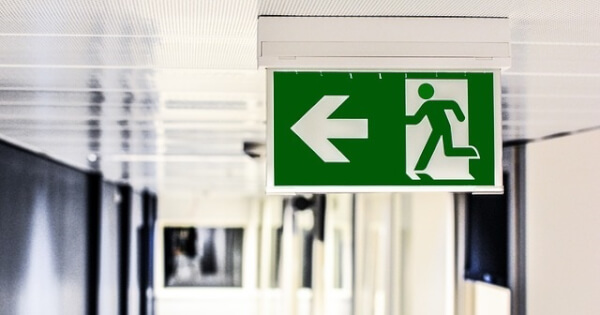
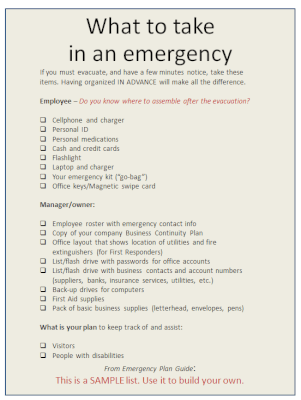
 We have written before about the shadowy world of nuclear power plants. In last week’s news I found another of the disconcerting developments connected with plants that have been shut down and that are going through the “decommissioning process.”
We have written before about the shadowy world of nuclear power plants. In last week’s news I found another of the disconcerting developments connected with plants that have been shut down and that are going through the “decommissioning process.”




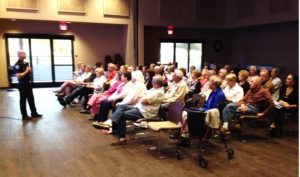 We invited the new head of our city’s Office of Energy Management. And since he is new to the job, we provided him with . . .
We invited the new head of our city’s Office of Energy Management. And since he is new to the job, we provided him with . . .
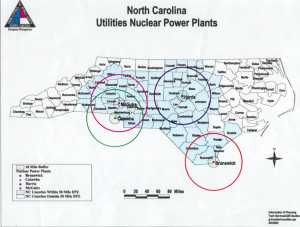



 The US Department of Labor has a division called Occupational Safety and Health Administration, otherwise known as OSHA. I’m sure you’ve heard of it!
The US Department of Labor has a division called Occupational Safety and Health Administration, otherwise known as OSHA. I’m sure you’ve heard of it!

